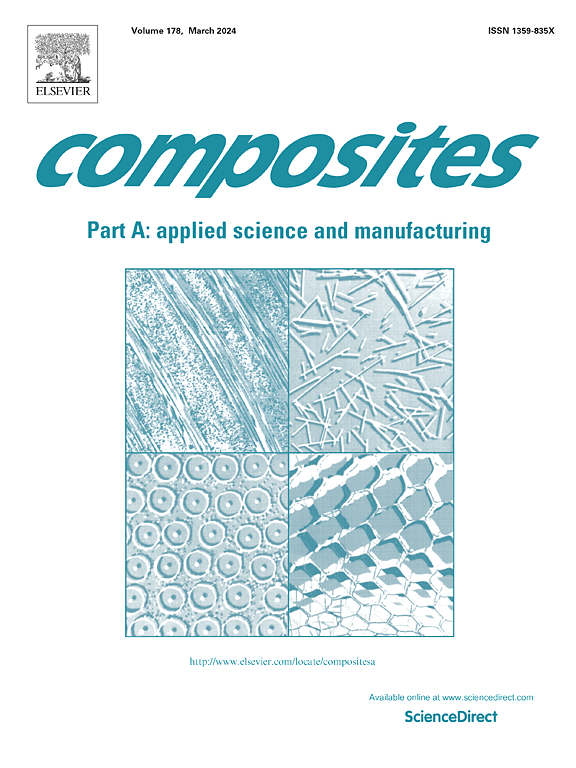Balanced optimization of multiple mechanical properties of homogeneous architecture hyperelastic material
IF 8.1
2区 材料科学
Q1 ENGINEERING, MANUFACTURING
Composites Part A: Applied Science and Manufacturing
Pub Date : 2025-04-14
DOI:10.1016/j.compositesa.2025.108932
引用次数: 0
Abstract
The fascinating mechanical properties of hyperelastic materials have been extensively studied. To meet the requirements of various application scenarios, researchers need to seek trade-offs and optimizations in different deformation modes, as these properties are often mutually restrictive. Machine learning with powerful nonlinear fitting ability, helps establish a balance between various mechanical properties, and facilitates iterative optimization in the manufacturing process of hyperelastic materials. Here, we propose a design strategy that reconciles the conflicting multiple mechanical properties of porous hyperelastic materials by using customized machine learning. Specifically, we combined multitask machine learning with targeted modules and domain knowledge from porous elastomer, and established the connection between the macroscopic structural parameters and multiple mechanical properties during the entire response process of hyperelastic materials obtained from additive manufacturing. By leveraging the connection, the contradiction between stiffness and energy dissipation in hyperelastic materials can be mitigated solely through macroscopic stacked structural optimization. The strategy is also employed to optimize the printing performance of silicone ink, demonstrating satisfactory results. Therefore, this strategy is expected to provide an efficient paradigm for simultaneously reconciling and optimizing the complex practical requirements of hyperelastic materials.
均质结构超弹性材料多种力学性能的平衡优化
超弹性材料令人着迷的力学性能得到了广泛的研究。为了满足各种应用场景的要求,研究人员需要在不同的变形模式下寻求权衡和优化,因为这些特性往往是相互限制的。机器学习具有强大的非线性拟合能力,有助于在超弹性材料的制造过程中建立各种力学性能之间的平衡,便于迭代优化。在这里,我们提出了一种设计策略,通过使用定制机器学习来协调多孔超弹性材料的多种力学性能的冲突。具体而言,我们将多任务机器学习与多孔弹性体的目标模块和领域知识相结合,建立了增材制造获得的超弹性材料在整个响应过程中的宏观结构参数与多种力学性能之间的联系。利用这种联系,可以仅通过宏观的叠层结构优化来缓解超弹性材料的刚度与耗能之间的矛盾。将该策略应用于有机硅油墨的印刷性能优化,取得了满意的效果。因此,该策略有望为同时协调和优化超弹性材料的复杂实际要求提供一个有效的范例。
本文章由计算机程序翻译,如有差异,请以英文原文为准。
求助全文
约1分钟内获得全文
求助全文
来源期刊

Composites Part A: Applied Science and Manufacturing
工程技术-材料科学:复合
CiteScore
15.20
自引率
5.70%
发文量
492
审稿时长
30 days
期刊介绍:
Composites Part A: Applied Science and Manufacturing is a comprehensive journal that publishes original research papers, review articles, case studies, short communications, and letters covering various aspects of composite materials science and technology. This includes fibrous and particulate reinforcements in polymeric, metallic, and ceramic matrices, as well as 'natural' composites like wood and biological materials. The journal addresses topics such as properties, design, and manufacture of reinforcing fibers and particles, novel architectures and concepts, multifunctional composites, advancements in fabrication and processing, manufacturing science, process modeling, experimental mechanics, microstructural characterization, interfaces, prediction and measurement of mechanical, physical, and chemical behavior, and performance in service. Additionally, articles on economic and commercial aspects, design, and case studies are welcomed. All submissions undergo rigorous peer review to ensure they contribute significantly and innovatively, maintaining high standards for content and presentation. The editorial team aims to expedite the review process for prompt publication.
 求助内容:
求助内容: 应助结果提醒方式:
应助结果提醒方式:


